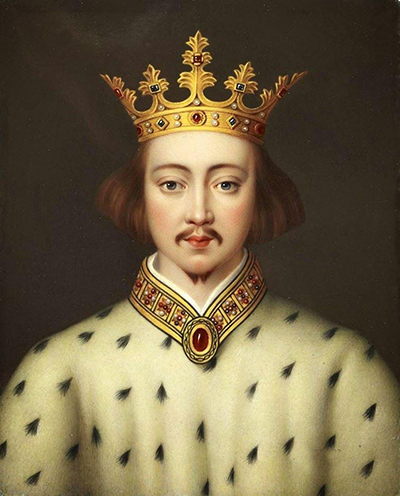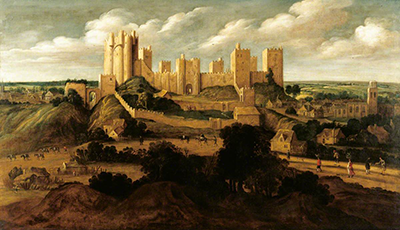



King Richard II Ė Quick Stats




Born: January 6, 1367
Because of his young age, England was ruled by a council of regents, primarily led by his uncles, John of Gaunt and Thomas of Woodstock. Although the council governed in his name, Richard was expected to take a more active role as he matured. His early reign was dominated by external conflicts, domestic unrest, and growing resentment between the king and the nobility.
At this stage, Richard began to embrace absolute monarchy, believing himself to be divinely appointed and beyond challenge. He also became increasingly obsessed with royal ceremony, surrounding himself with pageantry, luxury, and a grand court culture that distanced him from his nobles.
Richard II: The Tragic King Who Lost His Crown and Kingdom
Early Life and Path to the Throne
Richard II was born on January 6, 1367, in Bordeaux, Aquitaine, which was then an English-held territory in France. He was the second son of Edward, the Black Prince, one of Englandís most celebrated military commanders, and Joan of Kent, a woman of royal blood.
Richard II was born on January 6, 1367, in Bordeaux, Aquitaine, which was then an English-held territory in France. He was the second son of Edward, the Black Prince, one of Englandís most celebrated military commanders, and Joan of Kent, a woman of royal blood.
The rebels marched on London, seizing key locations and even executing some of the kingís advisors. Despite being only 14 years old, Richard personally rode out to negotiate with the rebels. He famously met with them at Smithfield, where Wat Tyler was killed in unclear circumstances. Afterward, Richard cleverly assured the rebels that their demands would be considered, but once the uprising lost momentum, he swiftly crushed the rebellion and executed its leaders.
The Lords Appellant and Richardís Early Conflicts
As Richard matured, he sought to break free from the control of his advisors and rule independently. Unlike his warrior-king grandfather and father, Richard focused on royal authority, courtly culture, and artistic patronage rather than military campaigns. He surrounded himself with favorites, such as Michael de la Pole, Robert de Vere, and Sir Simon Burley, whose influence alienated the powerful nobles of England.
As Richard matured, he sought to break free from the control of his advisors and rule independently. Unlike his warrior-king grandfather and father, Richard focused on royal authority, courtly culture, and artistic patronage rather than military campaigns. He surrounded himself with favorites, such as Michael de la Pole, Robert de Vere, and Sir Simon Burley, whose influence alienated the powerful nobles of England.
By the late 1380s, opposition to Richardís rule reached a boiling point. A group of noblemen known as the Lords Appellantóled by Thomas of Woodstock, the Duke of Gloucester; Henry Bolingbroke (Richardís cousin); and other powerful lordsóchallenged Richardís governance.
In 1387, the Lords Appellant led a rebellion against the kingís favorites, defeating Richardís forces at the Battle of Radcot Bridge and forcing him to accept their dominance. Many of his closest allies were executed or exiled. This event, known as the Merciless Parliament (1388), was a humiliating blow to Richard and left him deeply resentful. For nearly a decade, Richard bided his time, waiting for an opportunity to take revenge on those who had humiliated him.
King Richard II of England, the last ruler of the Plantagenet dynastyís direct line, reigned from 1377 to 1399. His reign was one of contrastsóbeginning with youthful promise and early displays of courage but later descending into tyranny, political miscalculations, and eventual deposition.
Died: February 14, 1400
Mother: Joan of Kent
Father: Edward, the Black Prince
Wives:
Children: None
This event solidified Richardís image as a bold young king capable of handling crises. However, as he grew older, his leadership style became increasingly autocratic, setting the stage for his downfall.
Deposition and Downfall: The Rise of Henry IV
In 1399, while Richard was away in Ireland suppressing a rebellion, Henry Bolingbroke returned to England with an army, initially claiming he only wanted to reclaim his rightful inheritance. However, his support quickly grew, and what began as a small uprising turned into a full-scale rebellion.
In 1399, while Richard was away in Ireland suppressing a rebellion, Henry Bolingbroke returned to England with an army, initially claiming he only wanted to reclaim his rightful inheritance. However, his support quickly grew, and what began as a small uprising turned into a full-scale rebellion.
Richardís fate remained uncertain, but in February 1400, he was likely murdered by starvation (or possibly executed) in Pontefract Castle. His body was quietly transported to Westminster Abbey and buried without royal honors.
Legacy of Richard II
Richard IIís reign is often viewed as a cautionary tale of an intelligent but politically inept monarch who miscalculated the power of his nobles. Unlike his predecessors, Richard was not a warrior-king, but a ruler who sought to strengthen royal authority through courtly culture, patronage, and absolute rule. His downfall marked the end of the direct Plantagenet line and the beginning of the Lancastrian dynasty under Henry IV.
Richard IIís reign is often viewed as a cautionary tale of an intelligent but politically inept monarch who miscalculated the power of his nobles. Unlike his predecessors, Richard was not a warrior-king, but a ruler who sought to strengthen royal authority through courtly culture, patronage, and absolute rule. His downfall marked the end of the direct Plantagenet line and the beginning of the Lancastrian dynasty under Henry IV.
Despite his failure as a ruler, Richardís influence on English culture was significant. He was a great patron of the arts, literature, and architecture, commissioning lavish projects and supporting poets such as Geoffrey Chaucer, author of The Canterbury Tales. He also introduced the use of the white hart as a royal emblem, which became a lasting symbol in English heraldry. Richardís life and reign were immortalized by William Shakespeareís play Richard II, which portrays him as a tragic figure, undone by his belief in divine kingship and his inability to navigate the realities of medieval power.
Conclusion
Richard IIís reign was one of promise, conflict, and ultimate failure. Though he was a cultured and visionary king, his desire for absolute power, his mismanagement of the nobility, and his alienation of key allies led to his dramatic downfall. His deposition in 1399 was one of the most significant turning points in English history, marking the rise of the House of Lancaster and setting the stage for the later conflicts of the Wars of the Roses.
Richard IIís reign was one of promise, conflict, and ultimate failure. Though he was a cultured and visionary king, his desire for absolute power, his mismanagement of the nobility, and his alienation of key allies led to his dramatic downfall. His deposition in 1399 was one of the most significant turning points in English history, marking the rise of the House of Lancaster and setting the stage for the later conflicts of the Wars of the Roses.
Unlike his predecessors, Richard was not a warrior-king but a ruler who sought to strengthen the monarchy through absolutism and ceremony. His belief in divine kingship and his inability to manage powerful nobles led to his downfall, making his reign one of the most dramatic in medieval English history.
Richardís older brother, Edward of AngoulÍme, died in childhood, leaving Richard as the sole heir to his fatherís vast legacy. However, his father, the Black Prince, fell seriously ill and died in 1376óone year before King Edward III, Richardís grandfather. This meant that when Edward III passed away in June 1377, the ten-year-old Richard inherited the throne.
Successor : King Henry IV
Predecessor : King Edward III
The Peasantsí Revolt of 1381: A Defining Moment
One of the most significant events of Richardís early reign was the Peasantsí Revolt of 1381, a massive uprising that shook England. The revolt stemmed from widespread economic hardship, oppressive taxation, and lingering effects of the Black Death, which had devastated Englandís population.
One of the most significant events of Richardís early reign was the Peasantsí Revolt of 1381, a massive uprising that shook England. The revolt stemmed from widespread economic hardship, oppressive taxation, and lingering effects of the Black Death, which had devastated Englandís population.
Pontefract Catle Where King Richard II was imprisoned
Anne of Bohemia
Isabella of Valois

A particularly unpopular poll tax, levied to fund Englandís war with France, sparked outrage among peasants, who believed they were being unfairly burdened. The rebellion was led by Wat Tyler, John Ball, and other radical figures who called for an end to serfdom and feudal obligations.
Richardís Tyrannical Rule and Personal Reign
By the 1390s, Richard had consolidated his power and ruthlessly struck back against the Lords Appellant. In 1397, he had several of them arrested, including his uncle, Thomas of Woodstock, who was mysteriously murdered in captivityólikely on Richardís orders. Other rivals were executed or exiled, and Richard now ruled without parliamentary oversight.
By the 1390s, Richard had consolidated his power and ruthlessly struck back against the Lords Appellant. In 1397, he had several of them arrested, including his uncle, Thomas of Woodstock, who was mysteriously murdered in captivityólikely on Richardís orders. Other rivals were executed or exiled, and Richard now ruled without parliamentary oversight.
He introduced a controversial financial policy called ďblank chartersĒ, which allowed him to demand funds from landowners without parliamentary approval. These actions angered both the nobility and common people, who viewed his rule as tyrannical. His greatest mistake came in 1398, when he exiled his cousin, Henry Bolingbroke, son of John of Gaunt, over a dispute. When John of Gaunt died in 1399, Richard seized Bolingbrokeís lands instead of allowing him to inherit them. This act of blatant injustice set the stage for his downfall.

Richard, caught off guard, found himself isolated and without significant allies. When he returned from Ireland, he was captured by Henryís forces and imprisoned in Pontefract Castle. In September 1399, Richard was forced to abdicate the throne, and Henry Bolingbroke was crowned as King Henry IV.


